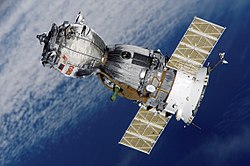 | |
| Operator | Roscosmos |
|---|---|
| COSPAR ID | 2007-045A |
| SATCAT no. | 32256 |
| Mission duration | 191 days, 19 hours, 17 minutes |
| Spacecraft properties | |
| Spacecraft type | Soyuz-TMA 11F732 |
| Manufacturer | Energia |
| Crew | |
| Crew size | 3 |
| Members | Yuri Malenchenko Peggy A. Whitson |
| Launching | Sheikh Muszaphar Shukor |
| Landing | Yi So-Yeon |
| Start of mission | |
| Launch date | October 10, 2007, 13:22:39 UTC |
| Rocket | Soyuz-FG |
| Launch site | Baikonur 1/5 |
| End of mission | |
| Landing date | April 19, 2008, 08:30 UTC |
| Orbital parameters | |
| Reference system | Geocentric |
| Regime | Low Earth |
| Inclination | 51.6 degrees |
| Docking with ISS | |
| Docking port | Zarya |
| Docking date | 12 October 2007 14:50 UTC |
| Undocking date | 19 April 2008 05:06 UTC |
| Time docked | 189d 14h 16m |
  From left to right: Sheikh Muszaphar Shukor, Yuri Malenchenko, Peggy Whitson Soyuz programme (Crewed missions) | |
Soyuz TMA-11 was a human spaceflight mission using a Soyuz-TMA spacecraft to transport personnel to and from the International Space Station (ISS). The mission began at 13:22 UTC on October 10, 2007, when the spacecraft was launched from the Baikonur Cosmodrome by a Soyuz FG launch vehicle. It brought to the station two members of the ISS Expedition 16 crew, as well as Sheikh Muszaphar, the first Malaysian in space. TMA-11 remained at the station as an escape craft, and returned safely to Earth on April 19, 2008, after it had been replaced by Soyuz TMA-12. Although the vehicle landed safely, it suffered a partial separation failure which caused a ballistic re-entry that in turn caused it to land 475 km from the intended landing point.


